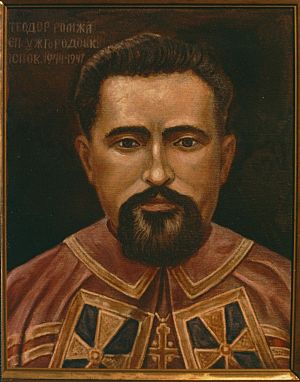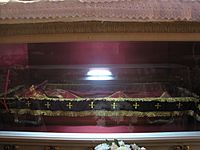Theodore Romzha facts for kids
Quick facts for kids Blessed Martyr Theodore Romzha |
|
|---|---|
| Eparch of Mukacheve | |
 |
|
| Church | Ruthenian Greek Catholic Church |
| Diocese | Eparchy of Mukacheve |
| Appointed | 8 September 1944 |
| Reign ended | 31 October 1947 |
| Predecessor | Oleksandr Stoika |
| Successor | vacant till 1983, then Ivan Semedi |
| Orders | |
| Ordination | 25 December 1936 (Priest) |
| Consecration | 24 September 1944 (Bishop) |
| Personal details | |
| Born | 14 April 1911 Nagybocskó, Austria-Hungary (now Velykyi Bychkiv, Ukraine) |
| Died | 31 October 1947 (aged 36) Uzhhorod, Ukrainian SSR |
| Sainthood | |
| Feast day | 31 October (martyrdom); 28 June (translation of relics) |
| Venerated in | Greek Catholic Churches Roman Catholic Church |
| Title as Saint | Blessed Martyr |
| Beatified | 27 June 2001 Lviv by Pope John Paul II |
Theodore George Romzha (Ukrainian: Теодор Юрій Ромжа, Hungarian: Romzsa Tódor György, 14 April 1911 – 31 October 1947) was an important leader of the Ruthenian Greek Catholic Church. He served as the bishop of the Eparchy of Mukacheve from 1944 until 1947. He was killed by the Soviet secret police (NKVD). Later, Pope John Paul II declared him a blessed martyr on June 27, 2001. A martyr is someone who dies for their faith.
Contents
Early life and studies
Theodore Romzha was born on April 14, 1911. His village, Nagybocskó, was in a region called Subcarpathia. This area was part of Austria-Hungary at the time. Today, it is known as Velykyi Bychkiv in Ukraine. His family spoke Hungarian at home. They also spoke Ukrainian when others were around.
His father, Pavel Romzha, worked for the railroad. His mother, Maria Semack, was a homemaker. After finishing high school in Chust (now Khust), Theodore decided to study to become a priest. He moved to Rome, Italy, to attend seminary. He studied at two different colleges there. He completed his studies at the Papal Gregorian University in Rome.
Theodore became a priest on Christmas Day, 1936. Bishop Alexander Evreinov ordained him in the Basilica of St Mary Major. After serving in the army, he worked as a pastor in a few villages. In 1939, he became a professor of philosophy. He taught at the Eparchial Seminary in Ungvár (now Uzhhorod).
Becoming a bishop
These years were very hard for the Church in Subcarpathia. The region changed hands many times. It was part of Czechoslovakia, then Hungary, and briefly Nazi Germany. Finally, the Red Army arrived, and it became part of the Soviet Union.
During these difficult times, Theodore Romzha treated all people equally. He spoke to his priests in their own languages. He used his name in both Hungarian and Ukrainian forms.
On September 24, 1944, Romzha became a bishop. He was only 33 years old. He was appointed the leader of the Eparchy of Munkács (now Mukacheve). This happened in the cathedral of Ungvár. Soon after, he faced the Soviet Red Army. They took over churches and arrested priests. Bishop Romzha bravely refused to break ties with the Pope.
He organized a big celebration for the Feast of the Assumption. Over 80,000 people attended. The Communist officials did not like this. They began to plan against the young bishop.
His death
On October 27, 1947, Bishop Romzha was returning from a visit to a church. His horse-drawn carriage was hit on purpose by a Soviet military truck. Soldiers, dressed as civilians, jumped out and beat the bishop and his friends.
Another truck arrived, and the attackers ran away. Romzha and his companions were taken to a hospital in Uzhhorod. Bishop Romzha seemed to be getting better. But late on October 31, the nuns caring for him were suddenly sent away. A new nurse was assigned to him by the government. Soon after midnight, Romzha was found dead. The nurse had poisoned him with an injection. This poison was provided by a secret Soviet laboratory. Research in Soviet records shows that Nikita Khrushchev himself ordered the bishop's murder.
On November 4, 1947, many people attended Romzha's funeral. This was despite Soviet efforts to stop public transport. He was buried in the crypt of the Holy Cross Cathedral in Uzhhorod. The Ruthenian Greek Catholic Church faced harsh treatment. In 1949, it was officially shut down. All its properties were given to the Russian Orthodox Church.
Honoring his memory
Pope John Paul II declared Romzha a blessed martyr on June 27, 2001. This happened in Lviv, Ukraine. His feast day was first set for November 1. Later, it was changed to October 31. This is because he died just after midnight on November 1 by Moscow time. But by local time, he died before midnight on October 31.
In 1998, the remains of Blessed Theodore were found. They were in a tomb in the crypt of Holy Cross Cathedral in Uzhhorod. His remains were then taken to Budapest, Hungary, for medical study. On June 27–28, 2003, his remains were brought back to Uzhhorod. They are now kept in a special chapel at Holy Cross Cathedral. To remember this event, a second feast day is celebrated on June 28. It is called the Translation of the Holy Relics of Blessed Theodore Romzha.
Important letter
A general of state security, Pavlo Sudoplatov, wrote a letter. In it, he said that Romzha was "eliminated in Mukachiv." He stated that this was done "according to the instructions of Kruschev." Romzha was the head of the Greek Catholic Church. He had strongly opposed joining Greek Catholics with the Orthodox Church.
See also
 In Spanish: Teodor Romzha para niños
In Spanish: Teodor Romzha para niños


